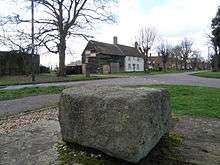Leightonstone
Leightonstone was a hundred of Huntingdonshire mentioned in the Domesday Book. [1] It took its name from the stone[2] at Leighton Bromswold where the area's moot was held.[3] In modern times it was an ecclesiastical administrative area within the Diocese of Ely. [4]

The Hundred of Leightonstone containing the parishes of Alconbury-Cum-Weston; Barham; Brampton; Brington; Buckworth; Bythorn; Catworth; Copmanford; Covington; Easton; Ellington; Great Gidding; Little Gidding; Steeple Gidding; Grafham; Hamerton; Keyston; Kimbolton; Leighton Bromswold; Molesworth; Spaldwick; Stow Longa; Swineshead; Thurning (part); Tilbrook; Upton; Old Weston; Winwick (part); Woolley
In two cases in the Domesday Book (in the lands of Eustace the Sheriff, and in those of the Countess Judith), the lands of this hundred are given as in Kimbolton Hundred. It is possible that this may have been an alternative name, but it is more probably due to a mistake of the Domesday scribe.[5]
Notes
- Domesday Book Map
- Geograph
- 'The hundred of Leightonstone', A History of the County of Huntingdon: Volume 3 (1936), pp. 1-3. URL: http://www.british-history.ac.uk/report.aspx?compid=66132 Date accessed: 19 October 2011
- Crockford’s on-line accessed: 19 October 2011
- 'The hundred of Leightonstone', A History of the County of Huntingdon: Volume 3 (1936), pp. 1–3. URL: http://www.british-history.ac.uk/report.aspx?compid=66132